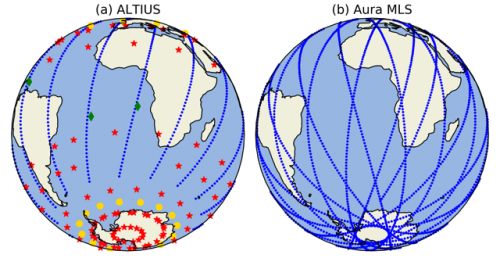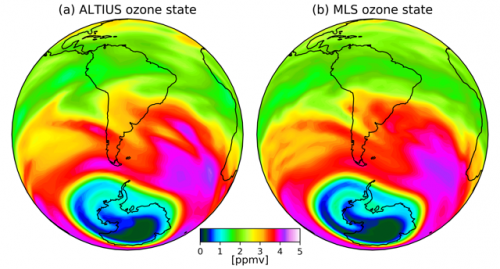Why do we need to monitor the ozone layer?
The stratospheric ozone layer is an essential component of the Earth system. By absorbing ultraviolet solar light, it protects the Earth’s surface from harmful radiation.
Surface emissions of halogen compounds, whose production has been banned progressively after the signature of the Montreal protocol in 1987, are still responsible for the reduction of the ozone layer worldwide. The monitoring of the stratospheric composition – and ozone in particular - is thus crucial.
Why ALTIUS?
Global observation of the stratospheric ozone distribution is done since more than 40 years by remote sensing satellite instruments. Several measurement techniques have been developed, each with their pro’s and con’s.
- Instruments measuring in the infrared or microwave part of the electromagnetic spectrum have the advantage to provide observations during the day and night side of the satellite orbit – thus covering the polar night – with consequently a relatively good spatial coverage (e.g. see Fig. 1b for the NASA Microwave Limb Sounder - MLS). On the other hand, they are relatively costly because of their used technology and their weight (heavy satellites mean large rockets, hence larger cost).
- Instruments measuring in the ultraviolet (UV) and visible (VIS) spectral regions are more affordable but were so far limited in their spatial coverage.
- Those measuring the solar occultation, i.e. the solar light passing through the limb of the atmosphere, were limited to two profiles per orbit.
- Those measuring the limb-scattered solar light were limited to the day side of the orbit.
- And finally those measuring stellar or planetary occultations were limited to the night side of the orbit but with much less profiles than in the bright limb mode.
The ALTIUS mission, initiated by BIRA-IASB and currently in its advanced development phase, will be the first UV-VIS instrument which combines these three measurement modes to maximize its spatial coverage (see Fig. 1a).
Value of ALTIUS
We have compared the value of ALTIUS with the reference NASA MLS instrument using an Observing System Simulation Experiment (OSSE).
In a first experiment, MLS ozone profiles were ingested in the BIRA-IASB stratospheric model, BASCOE, which provided us a “MLS ozone state”.
Combining the obtained ‘MLS ozone state’ with an ALTIUS instrument simulator, we were able to generate synthetic ALTIUS ozone profiles. These profiles were equally ingested into BASCOE providing the “ALTIUS ozone state”.
The good agreement between both states (see Fig. 2) confirms that UV-VIS instruments could continue the monitoring of the ozone layer.
Reference
Errera, Q., Dekemper, E., Baker, N., Debosscher, J., Demoulin, P., Mateshvili, N., Pieroux, D., Vanhellemont, F., and Fussen, D. (2021). On the capability of UV-VIS limb sounders to constrain modelled stratospheric ozone and its application to the ALTIUS mission. Atmospheric Measurement Techniques Discussions [preprint] . https://doi.org/10.5194/amt-2020-512 


